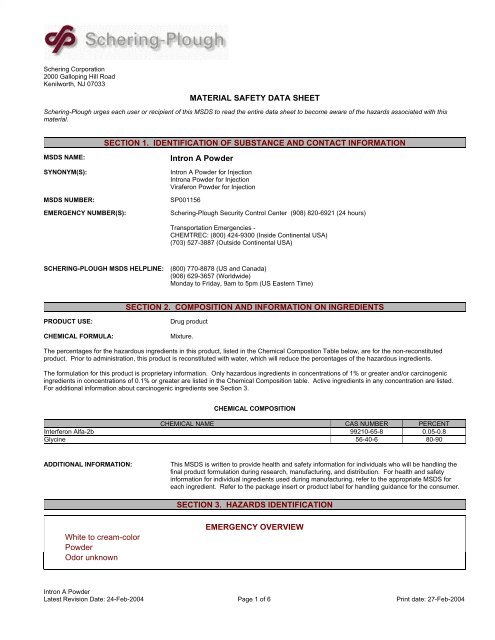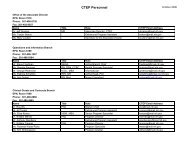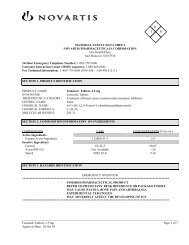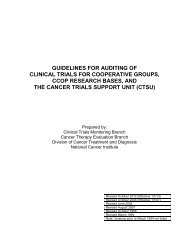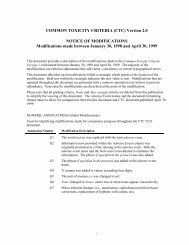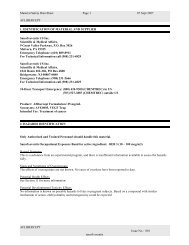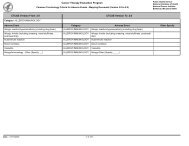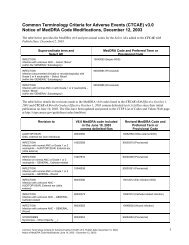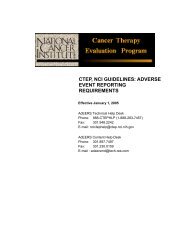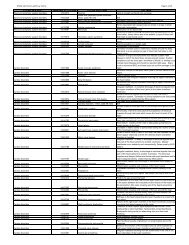MATERIAL SAFETY DATA SHEET SECTION 1. IDENTIFICATION ...
MATERIAL SAFETY DATA SHEET SECTION 1. IDENTIFICATION ...
MATERIAL SAFETY DATA SHEET SECTION 1. IDENTIFICATION ...
Create successful ePaper yourself
Turn your PDF publications into a flip-book with our unique Google optimized e-Paper software.
Schering Corporation<br />
2000 Galloping Hill Road<br />
Kenilworth, NJ 07033<br />
<strong>MATERIAL</strong> <strong>SAFETY</strong> <strong>DATA</strong> <strong>SHEET</strong><br />
Schering-Plough urges each user or recipient of this MSDS to read the entire data sheet to become aware of the hazards associated with this<br />
material.<br />
<strong>SECTION</strong> <strong>1.</strong> <strong>IDENTIFICATION</strong> OF SUBSTANCE AND CONTACT INFORMATION<br />
MSDS NAME: Intron A Powder<br />
SYNONYM(S): Intron A Powder for Injection<br />
Introna Powder for Injection<br />
Viraferon Powder for Injection<br />
MSDS NUMBER: SP001156<br />
EMERGENCY NUMBER(S): Schering-Plough Security Control Center (908) 820-6921 (24 hours)<br />
Transportation Emergencies -<br />
CHEMTREC: (800) 424-9300 (Inside Continental USA)<br />
(703) 527-3887 (Outside Continental USA)<br />
SCHERING-PLOUGH MSDS HELPLINE: (800) 770-8878 (US and Canada)<br />
(908) 629-3657 (Worldwide)<br />
Monday to Friday, 9am to 5pm (US Eastern Time)<br />
<strong>SECTION</strong> 2. COMPOSITION AND INFORMATION ON INGREDIENTS<br />
PRODUCT USE: Drug product<br />
CHEMICAL FORMULA: Mixture.<br />
The percentages for the hazardous ingredients in this product, listed in the Chemical Compostion Table below, are for the non-reconstituted<br />
product. Prior to administration, this product is reconstituted with water, which will reduce the percentages of the hazardous ingredients.<br />
The formulation for this product is proprietary information. Only hazardous ingredients in concentrations of 1% or greater and/or carcinogenic<br />
ingredients in concentrations of 0.1% or greater are listed in the Chemical Composition table. Active ingredients in any concentration are listed.<br />
For additional information about carcinogenic ingredients see Section 3.<br />
CHEMICAL COMPOSITION<br />
CHEMICAL NAME CAS NUMBER PERCENT<br />
Interferon Alfa-2b 99210-65-8 0.05-0.8<br />
Glycine 56-40-6 80-90<br />
ADDITIONAL INFORMATION: This MSDS is written to provide health and safety information for individuals who will be handling the<br />
final product formulation during research, manufacturing, and distribution. For health and safety<br />
information for individual ingredients used during manufacturing, refer to the appropriate MSDS for<br />
each ingredient. Refer to the package insert or product label for handling guidance for the consumer.<br />
White to cream-color<br />
Powder<br />
Odor unknown<br />
Intron A Powder<br />
Latest Revision Date: 24-Feb-2004<br />
<strong>SECTION</strong> 3. HAZARDS <strong>IDENTIFICATION</strong><br />
EMERGENCY OVERVIEW<br />
Page 1 of 6<br />
Print date: 27-Feb-2004
May be harmful by inhalation.<br />
May cause allergic reactions in susceptible individuals.<br />
May cause effects to:<br />
- gastrointestinal tract<br />
- respiratory system<br />
- immune system<br />
- cardiovascular system<br />
- endocrine system<br />
- nervous system<br />
- eye<br />
- brain<br />
- liver<br />
- female reproductive system<br />
- fetus<br />
POTENTIAL HEALTH EFFECTS:<br />
The following summary is based upon available information about the individual ingredients of the mixture, or of the expected properties of the<br />
mixture.<br />
Interferon alfa-2b (active ingredient of Intron A) is an alfa interferon protein used for the treatment of certain types of cancer, chronic hepatitis B,<br />
anal/genital warts (condylomata acuminata), and AIDS-related Kaposi's Syndrome. Intron A is administered by injection either alone or as<br />
peginterferon alfa-2b (active ingredient of PEG-Intron), a covalent conjugate of interferon alfa-2b and polyethylene glycol.<br />
The most common effects observed during therapy with interferon alfa-2b or peginterferon alfa-2b products were "flu-like" symptoms (e.g. fever,<br />
headache, fatigue, chills, muscle or joint pain, dizziness), gastrointestinal effects (e.g. anorexia, diarrhea, dizziness, nausea, vomiting, stool<br />
changes), depression, taste alteration, or parasthesia (tingling or numbness of extremities). These effects were mild to moderate in severity and<br />
were reversible. Other effects observed during therapy include skin rashes (psoriasis), effects to eyes (decrease or loss of vision), bone marrow<br />
toxicity (decreases in white blood cell and platelet counts), life-threatening or fatal neuropsychiatric events (suicidal tendencies, hallucinations,<br />
aggressive behavior), hypo- or hyperthyroidism, hyperglycemia, diabetes, cardiovascular effects (decreases in blood pressure, abnormal heart<br />
rhythm, decreased blood flow), lung effects (shortness of breath, pneumonia, bronchitis), colon inflammation, liver effects (elevated serum liver<br />
enzyme levels, insufficiency, failure), or serious hypersensitivity reactions (i.e. anaphylaxis).<br />
Human leukocyte interferon has been reported to cause decreases in serum estradiol and progesterone concentrations in women as well as<br />
irregular menstrual cycles. In monkeys, embryolethality was reported in two separate studies, one of which also reported maternal toxicity at the<br />
same doses. However, four women treated with interferon alfa-2a during pregnancy gave birth without complication and infants appeared normal at<br />
birth and had normal development. Relevance of animal developmental toxicity to humans is unclear.<br />
Glycine is a nonessential amino acid found in the body. Glycine is not expected to produce adverse effects when handled according to safe work<br />
practices. It may cause irritation to the eyes, skin, and respiratory tract from mechanical action. Exposure to large amounts of glycine may cause<br />
transurethral resection of the prostate (TURP) syndrome. Symptoms of TURP syndrome may include ammonia toxicity including nausea, vomiting,<br />
and central nervous depression, low blood pressure, headache, visual disturbance or loss, restlessness, chest pain, agitation, confusion, or<br />
weakness.<br />
LISTED CARCINOGENS<br />
No carcinogens or potential carcinogens listed by OSHA, IARC, NTP or ACGIH are present in concentrations >0.1% in this mixture.<br />
<strong>SECTION</strong> 4. FIRST AID MEASURES<br />
INHALATION: Remove to fresh air. If any trouble breathing, get immediate medical attention. Administer artificial<br />
respiration if breathing has ceased. If irritation or symptoms occur or persist, consult a physician.<br />
SKIN CONTACT: In case of skin contact, while wearing protective gloves, carefully remove any contaminated clothing,<br />
including shoes, and wash skin thoroughly with soap and water. If irritation or symptoms occur or<br />
persist, consult a physician.<br />
EYE CONTACT: In case of eye contact, immediately rinse eyes thoroughly with plenty of water. If wearing contact<br />
lenses, remove only after initial rinse, and continue rinsing eyes for at least 15 minutes. If irritation<br />
occurs or persists, consult a physician.<br />
INGESTION: Rinse mouth and drink a glass of water. Do not induce vomiting. If symptoms persist, consult a<br />
physician.<br />
Intron A Powder<br />
Latest Revision Date: 24-Feb-2004<br />
Page 2 of 6 Print date: 27-Feb-2004
NOTE TO PHYSICIAN: Interferon alfa-2b is a protein used for the treatment of certain types of cancer, chronic hepatitis B and<br />
C, condylomata acuminata or AIDS-related Kaposi's sarcoma. Interferon alfa-2b is either administered<br />
alone or is covalently conjugated with polyethylene glycol forming peginterferon alfa-2b. Alpha<br />
interferons have been shown to cause fatal or life-threatning neuropsychiatric, autoimmune, ischemic,<br />
and infectious disorders. Common effects observed during therapy with alpha interferons are "flulike"symptoms.<br />
Serious hypersensitivity reactions (anaphylaxis) may occur in sensitive individuals<br />
exposed to alpha interferons.<br />
FLAMMABILITY <strong>DATA</strong>:<br />
<strong>SECTION</strong> 5. FIRE FIGHTING MEASURES<br />
FLASH POINT: Not determined (liquids) or not applicable (solids).<br />
OTHER EXPLOSION HAZARDS:<br />
Under normal conditions of use, this material does not present a significant fire or explosion hazard. However, like most organic compounds, this<br />
material may present a dust deflagration hazard if sufficient quantities are suspended in air. This hazard may exist where sufficient quantities of<br />
finely divided material are (or may become) suspended in air during typical process operations. An assessment of each operation should be<br />
conducted and suitable deflagration prevention and protection techniques employed.<br />
The sensitivity of this material to ignition by electrostatic discharges has not been determined. In the absence of testing data, all conductive plant<br />
items and operations personnel handling this material should be suitably grounded.<br />
SPECIAL FIRE FIGHTING PROCEDURES:<br />
Wear full protective clothing and self-contained breathing apparatus (SCBA).<br />
SUITABLE EXTINGUISHING MEDIA:<br />
Carbon dioxide (CO2), extinguishing powder or water spray.<br />
See Section 9 for Physical and Chemical Properties.<br />
<strong>SECTION</strong> 6. ACCIDENTAL RELEASE MEASURES<br />
PERSONAL PRECAUTIONS:<br />
Avoid generation of dust during clean-up. Wear appropriate personal protective equipment as specified in Section 8. Keep personnel away from the<br />
clean-up area.<br />
SPILL RESPONSE / CLEANUP:<br />
All spills should be handled according to site requirements and based on precautions cited in the MSDS. In the case of liquids, use proper<br />
absorbent materials. For laboratories and small-scale operations, incidental spills within a hood or enclosure should be cleaned by using a HEPA<br />
filtered vacuum or wet cleaning methods as appropriate. For large dry or liquid spills or those spills outside enclosure or hood, appropriate<br />
emergency response personnel should be notified.<br />
See Sections 9 and 10 for additional physical, chemical, and hazard information.<br />
<strong>SECTION</strong> 7. HANDLING AND STORAGE<br />
HANDLING:<br />
Keep containers adequately sealed during material transfer, transport, or when not in use.<br />
Appropriate handling of this material is dependent on many factors, including physical form, duration and frequency of process or task, and<br />
effectiveness of engineering controls. Site-specific risk assessments should be conducted to determine the feasibility and the appropriateness of all<br />
exposure control measures. See Section 8 (Exposure Controls) for additional guidance.<br />
STORAGE:<br />
Store in a cool, dry, well ventilated area.<br />
See Section 8 for exposure controls and additional safe handling information.<br />
<strong>SECTION</strong> 8. EXPOSURE CONTROLS AND PERSONAL PROTECTION<br />
The following guidance applies to the handling of the active ingredient(s) in this formulation.<br />
S-P OCCUPATIONAL EXPOSURE GUIDELINE (OEG):<br />
Schering-Plough Corporation has established a preliminary Occupational Exposure Guideline (pOEG) of 0.05 mcg/m 3 (8-hr TWA; respirable<br />
fraction) for interferon alfa-2b. Consult your site safety professional for additional guidance.<br />
Intron A Powder<br />
Latest Revision Date: 24-Feb-2004<br />
Page 3 of 6 Print date: 27-Feb-2004
EXPOSURE CONTROLS:<br />
The health hazard risks of handling this material are dependent on many factors, including physical form, duration and frequency of process or task,<br />
and effectiveness of engineering controls. Site-specific risk assessments should be conducted to determine the feasibility and the appropriateness<br />
of all exposure control measures. Exposure controls for normal operating or routine procedures follow a tiered strategy. Engineering controls are<br />
the preferred means of long-term or permanent exposure control. If engineering controls are not feasible, appropriate use of personal protective<br />
equipment (PPE) may be considered as alternative control measures. However, PPE should not be used as a method of permanent or long-term<br />
exposure control. Exposure controls for non-routine operations must be evaluated and addressed as part of the site-specific risk assessment.<br />
RECOMMENDED PERSONAL PROTECTIVE EQUIPMENT (PPE):<br />
Respiratory Protection: Respiratory protective equipment (RPE) may be required for certain laboratory and large-scale<br />
manufacturing tasks if potential airborne breathing zone concentrations of substances exceed the<br />
relevant exposure limit(s). Workplace risk assessment should be completed before specifying and<br />
implementing RPE usage. Potential exposure points and pathways, task duration and frequency,<br />
potential employee contact with the substance, and the ability of the substance to be rendered airborne<br />
during specific tasks should be evaluated. Initial and ongoing strategies of quantitative exposure<br />
measurement should be obtained as required by the workplace risk assessment. All RPE must<br />
conform to local and regional specifications for efficacy and performance. Consult your site or<br />
corporate health and safety professional for additional guidance.<br />
Skin Protection: Gloves that provide an appropriate barrier to the skin are recommended if there is potential for contact<br />
with this material. Consult your site safety staff for guidance.<br />
Eye Protection: Safety glasses with side shields. Use of goggles or full face protection may be required if there is<br />
potential for contact with this material. Consult your site safety staff for guidance.<br />
Body Protection: In small-scale or laboratory operations, lab coats or equivalent protection is required. Disposable<br />
Tyvek or other dust impermeable suit should be considered based on procedure or level of exposure.<br />
Use of additional PPE such as shoe coverings, gauntlets, hood, or head covering may be necessary.<br />
Consult your site safety staff for guidance.<br />
In large-scale or manufacturing operations, disposable Tyvek or other dust impermeable suit is<br />
recommended and based on level of exposure. Use of additional PPE such as shoe coverings,<br />
gauntlets, hood, or head covering may be necessary. Consult your site safety staff for guidance.<br />
EXPOSURE LIMIT VALUES<br />
See Schering-Plough preliminary occupational exposure guideline (pOEG) listed above.<br />
<strong>SECTION</strong> 9. PHYSICAL AND CHEMICAL PROPERTIES<br />
FORM: Powder<br />
COLOR: White to cream-color<br />
ODOR: Odor unknown<br />
pH: 6.5 to 8.0 (Reconstituted solution)<br />
SOLUBILITY:<br />
Water: Soluble<br />
STABILITY/ REACTIVITY:<br />
Stable under normal conditions.<br />
INCOMPATIBLE <strong>MATERIAL</strong>S / CONDITIONS TO AVOID:<br />
None known.<br />
See Section 5 for flammability/explosivity information.<br />
<strong>SECTION</strong> 10. STABILITY AND REACTIVITY<br />
<strong>SECTION</strong> 1<strong>1.</strong> TOXICOLOGICAL INFORMATION<br />
The information presented below is for the active ingredient in this product. The information presented below is either for interferon alfa-2b, or for<br />
peginterferon alfa-2b, a conjugate of interferon alfa-2b and polyethylene glycol.<br />
Intron A Powder<br />
Latest Revision Date: 24-Feb-2004<br />
ACUTE TOXICITY <strong>DATA</strong><br />
Page 4 of 6 Print date: 27-Feb-2004
SKIN:<br />
Subcutaneous injections of Intron A to rats at doses of 5 MIU/mL (0.0192 mg/mL), equivalent to 4.5 MIU (0.017 mg) interferon alfa-2b, and 50<br />
MIU/mL (0.192 mg/mL), equivalent to 15 MIU (0.058 mg) interferon alfa-2b, caused slight to moderate tissue irritation. Minimal to moderate<br />
histopathic changes observed were mononuclear cell infiltration, hemorrhage, subcutaneous fibrin deposition, congestion of the subcutis, fibrinoid<br />
vascular necrosis, and necrosis of the panniculus carnosus.<br />
ADDITIONAL INFORMATION:<br />
Interferon alfa-2b did not cause mortality or systemic effects in rats dosed by intravenous or intramuscular injection at doses up to 165 MIU/kg (0.63<br />
mg/kg) or 330 MIU/kg (<strong>1.</strong>27 mg/kg), respectively.<br />
REPEAT DOSE TOXICITY <strong>DATA</strong><br />
SUBCHRONIC / CHRONIC TOXICITY:<br />
Ocular administration of interferon alfa-2b to rabbit eyes at a dose of 3.25 million IU/eye/day (0.013 mg/eye/day) for 21 days caused slight irritation.<br />
No systemic toxicity or microscopic changes were observed.<br />
Interferon alfa-2b was well tolerated in two strains of mice dosed with 1 and 10 million IU (0.0038 and 0.038 mg) intraperitoneally and in rats and<br />
non-human primates treated intramuscularly at doses of <strong>1.</strong>1 million IU (0.0042 mg) for one month. Effects noted in the one-month study included<br />
myositis, perivascular lymphocytic cuffs (non-human primates) and small focal lymphocytic infiltrates (non-human primates) at the injection site.<br />
Toxicity of interferon alfa-2b was also evaluated in non-human primates treated intramuscularly at doses ranging from 4 million to 100 million IU/kg<br />
(0.015 to 0.38 mg/kg) for three months. Interferon alfa-2b was well tolerated in the low-dose group. In the high-dose group, two animals were<br />
euthanized during weeks 2 and 4 in poor condition; effects noted in those animals included reduced food consumption, hyperemic oral mucosa,<br />
dehydration, hypoactivity, hypothermia, and decreased heart and respiratory rates. Additionally, one animal exhibited Kupffer cell hypertrophy and<br />
hyperplasia, pulmonary hemorrhage, and thickened alveolar walls, and the other exhibited hypoplasia of lymphoid tissue and hypoplastic bone<br />
marrow. Effects noted in animals that completed the scheduled dosing period included hyperemic oral mucosa, dehydration, gingival bleeding,<br />
prolonged menses in two animals, decreases in erythrocyte parameters and platelet counts, decreases in serum chemistry parameters, and<br />
erythroid hypoplasia of the bone marrow.<br />
REPRODUCTIVE / DEVELOPMENTAL TOXICITY:<br />
Interferon alfa-2b was administered to rhesus monkeys from day 20 to 80 of gestation at doses ranging from 7.5 million to 30 million IU/kg/day<br />
(0.029 to 0.12 mg/kg/day), 90 to 360 times the intramuscular and subcutaneous human dose. Interferon alfa-2b induced dose-dependent<br />
embryolethality without teratogenicity in the mid- and high-dose groups. However, maternal toxicity, including anorexia, diarrhea, constipation,<br />
depression, epistaxis, nasal discharge and weight loss, was also observed at these dose groups. In another study with interferon alfa-2a, a similar<br />
material, embryolethality was observed in monkeys at dosages ranging from 1 to 25 million IU/kg/day (0.0037 mg/kg to 0.09 mg/kg); maternal<br />
toxicity was not reported.<br />
Interferon alfa-2b caused an increase in the duration of the menstrual cycle and a delay in peak estradiol and progesterone levels in monkeys<br />
administered doses of 3.1 mg/m2 (0.26 mg/kg).<br />
MUTAGENICITY / GENOTOXICITY:<br />
Interferon alfa-2b containing three impurities (1A, 1B, and 2) was negative in a chromosome aberration study in human lymphocytes in the<br />
presence and absence of metabolic activation. Interferon alfa-2a, a similar material, was negative in a bacterial mutagenicity assay (Ames) and did<br />
not cause chromosomal damage in human lymphoctes. Human leukocyte interferon did not cause chromosome abnormaltiies in human leukocyte<br />
assays nor did it cause chromosome aberrations in chick embryo fibroblasts.<br />
Peginterferon alfa-2b was negative in a bacterial mutagenicity assay (Ames), a chromosomal aberration study in cultured whole blood human<br />
lymphocytes, and a mouse micronucleus assay.<br />
CARCINOGENICITY:<br />
This material has not been evaluated for carcinogenicity.<br />
<strong>SECTION</strong> 12. ECOLOGICAL INFORMATION<br />
ECOTOXICITY <strong>DATA</strong><br />
There are no ecototoxicity data available for this product or its components.<br />
ENVIRONMENTAL <strong>DATA</strong><br />
There are no environmental data available for this product or its components.<br />
<strong>SECTION</strong> 13. DISPOSAL CONSIDERATIONS<br />
<strong>MATERIAL</strong> WASTE:<br />
Disposal must be in accordance with applicable federal, state/provincial, and/or local regulations. Incineration is the preferred method of disposal,<br />
when appropriate. Operations that involve the crushing or shredding of waste materials or returned goods must be handled to meet the ECG or<br />
OEG.<br />
PACKAGING AND CONTAINERS:<br />
Disposal must be in accordance with applicable federal, state/provincial, and/or local regulations.<br />
Intron A Powder<br />
Latest Revision Date: 24-Feb-2004<br />
Page 5 of 6 Print date: 27-Feb-2004
<strong>SECTION</strong> 14. TRANSPORT INFORMATION<br />
This material is not subject to the transportation regulations of DOT, ICAO, IMO, and the ADR.<br />
<strong>SECTION</strong> 15. REGULATORY INFORMATION<br />
TSCA LISTING<br />
CHEMICAL NAME TSCA<br />
Glycine Listed<br />
U.S. STATE REGULATIONS<br />
Check state requirements for ingredient listing.<br />
<strong>SECTION</strong> 16. OTHER INFORMATION<br />
Although reasonable care has been taken in the preparation of this document, we extend no warranties and make no representations as to the<br />
accuracy or completeness of the information contained therein, and assume no responsibility regarding the suitability of this information for the<br />
user's intended purposes or for the consequence of its use. Each individual should make a determination as to the suitability of the information for<br />
their particular purpose(s).<br />
DEPARTMENT ISSUING MSDS: Global Safety and Environmental Affairs<br />
Occupational and Environmental Toxicology<br />
Schering-Plough Corporation<br />
1095 Morris Avenue<br />
Union, NJ 07083 USA<br />
SCHERING-PLOUGH MSDS HELPLINE: (800) 770-8878 (US and Canada)<br />
(908) 629-3657 (Worldwide)<br />
Monday to Friday, 9am to 5pm (US Eastern Time)<br />
MSDS CREATION DATE: 05-Jun-1995<br />
SUPERSEDES DATE: 05-Jun-1995<br />
Intron A Powder<br />
Latest Revision Date: 24-Feb-2004<br />
Page 6 of 6 Print date: 27-Feb-2004


